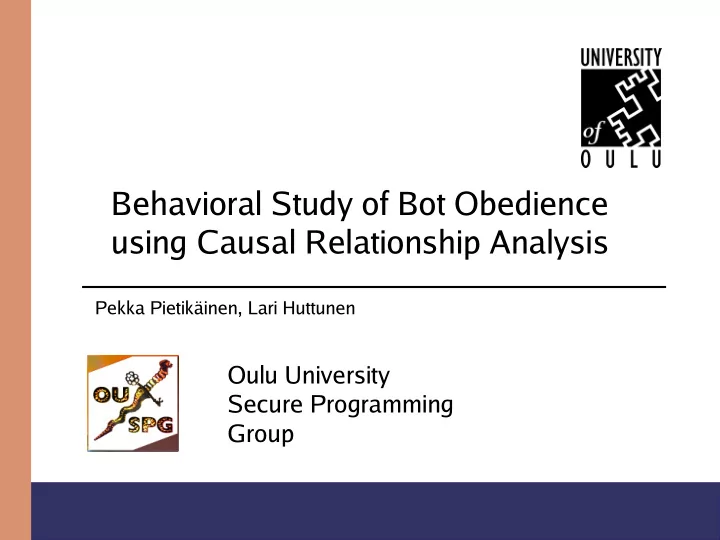

Behavioral Study of Bot Obedience using Causal Relationship Analysis Pekka Pietikäinen, Lari Huttunen Oulu University Secure Programming Group
• Botnets have become an increasing menace • Tens of strategically placed hosts to hundreds of thousands • Life-cycle: • Infection directly through the network or user interaction • Trojan payload downloaded and/or executed • Bot joins the botnet • Bots are used for some activity • Bots are upgraded to new versions Introduction
• Active/passive • Scope: Individual machines/network • Detection time: proactive/reactive • User: end-user, network operator etc. • Type: Indirect, Direct Detection mechanisms
Data source Scope Detection User Type time Victim Individual After Unhappy end- Direct, machine infection user Indirect Honeypot or Varies Early Security Direct spampot researcher Antivirus Individual Infection End-user, Direct software machine attempt network operator IDS with Network Infection Network Direct signature attempt operator IDS without Network After Network Indirect signature infection operator DNS-based IDS Network After Network Indirect infection operator Flow data Several Early to Network Direct, networks postmortem operator Indirect Botnet detection methods
• Attempt to collect live instances of malware • High-interaction (traditional honeypot) • Low-interaction (Nepenthes) • Only catches the low-hanging fruit • Privacy and liability issues • Requires expertise • Still, provides the best intelligence about botnets Honeypots and spampots
• Finds signatures of malware running on the system or malicious activity in general • Can only spot activity for which signatures exist • Usefulness as information source for botnet investigations depends on the deployment Anti-virus software
• Collect data from network and attempt to find botnet traffic • IRC traffic as signature • Easy to evade, just change the protocol a bit or encrypt • Legitimate traffic as false positives • Ephemeral port numbers -> have to look at all traffic • Secondary botnet behaviour • Portscans, DDoS’s etc. Intrusion detection systems
• New type of IDS especially useful for botnets • Catch anomalies in DNS queries • Known controllers • Popular hosts • Abnormal qtypes • False positives a problem • Correlate with NetFlow data • Passive DNS replication • Gets around privacy issues, but cannot be proactive DNS-based IDS
• Summary data collected at border router • Data rate is (almost) manageable • Timestamp, Source/destination address & port, protocol, packet count, byte count, ... • Isolating relevant data and anonymization needed for sharing NetFlow
• Method for modeling and visualizing interactions in network traffic • Groups potentially related events together Causality analysis
Total distinct addresses: 8293953 Total flows: 62393760 Control port flows: 18269 C&C hosts: 6 C&C flows: 18157 Number of victims: 546 Victim flows: 23753270 Control port flows: 17892 Port 445 flows: 23484991 Other traffic: 250387 Summary of incident
C&C port activity
Causality graph
• There is no single silver bullet for botnets • Correlation of data from several methods is needed • Flow + DNS-based IDS to find potential targets for further analysis • Causality analysis to understand botnet activities better • Sharing of data between organizations • Evidentiary value of flow data • Number of victims can be enumerated and monentary value estimated • Causality analysis can be used to minimize flow data to the essentials Conclusions
Recommend
More recommend